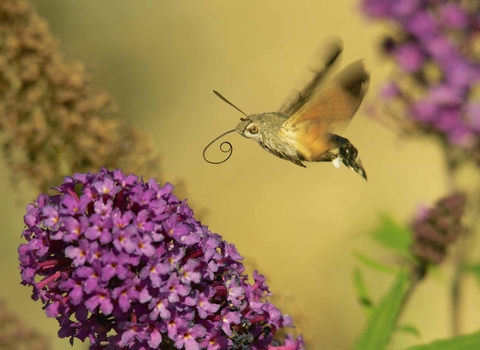
©Derek Moore
Hummingbird hawk-moth
The hummingbird hawk-moth migrates to the UK from Southern Europe each year. It can be seen hovering over flowers, feeding with its long proboscis; its wings move so quickly that it 'hums'.
Scientific name
Macroglossum stellatarumWhen to see
April to DecemberSpecies information
About
The hummingbird hawk-moth is a small, day-flying hawk-moth. It is a summer visitor to the UK, migrating from Southern Europe in variable numbers each year. In some years, it can be common and may be seen in gardens, hovering like a hummingbird as it feeds on the nectar of honeysuckle, red valerian and other flowers. It can also be found along woodland edges, and on heathland and scrub. The caterpillars feed on various species of bedstraw, so the female adult moths lay their eggs on the buds or flowers of these plants.How to identify
The hummingbird hawk-moth has greyish-brown forewings, bright orange hindwings, and a greyish body with a broad, black-and-white 'tail'. Its hovering flight is a distinguishing feature; it flutters its wings so quickly that it can appear orange and makes an audible hum.Distribution
A widespread migrant, most frequent in the south and near the coast.Did you know?
The hummingbird hawk-moth is the only 'hummingbird' in Europe: real hummingbirds are found in the Americas.Watch
Hummingbird hawk-moth (https://vimeo.com/473853257)
Hummingbird hawk-moth ©Tom Hibbert
